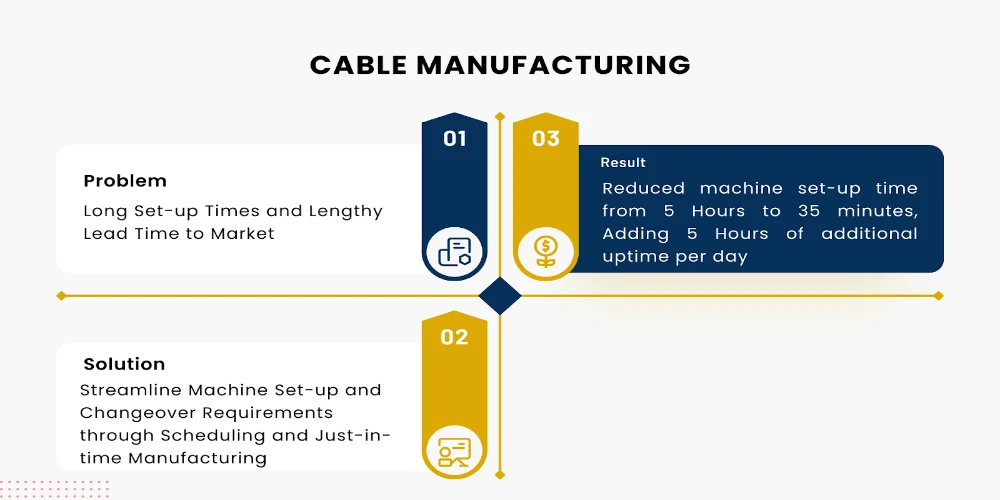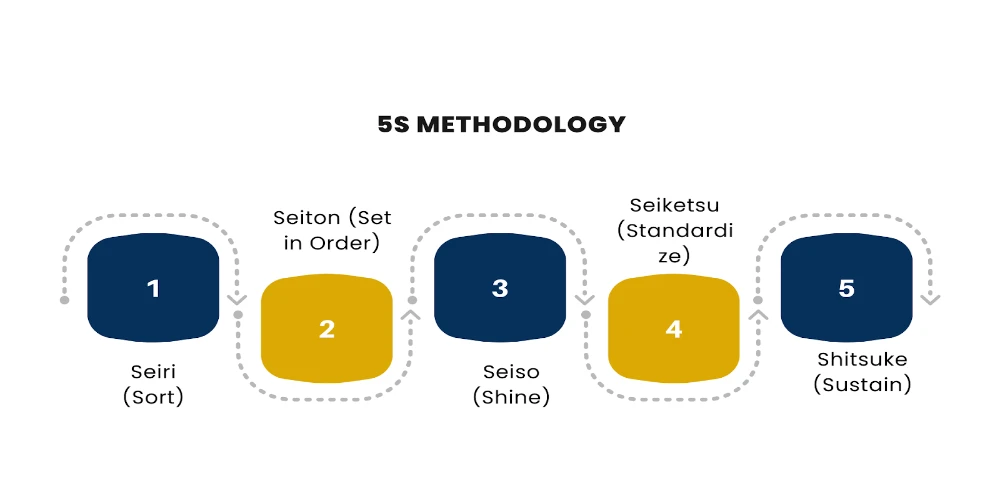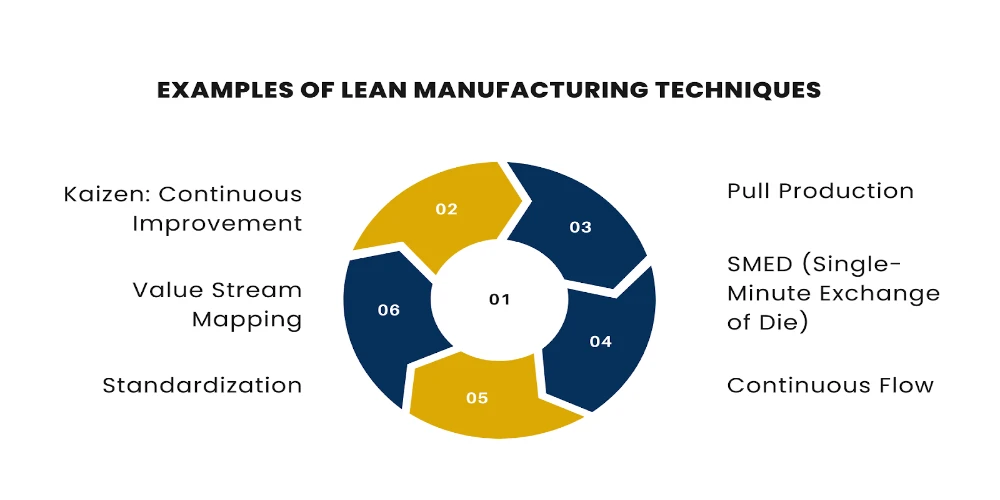The 8 Lean Six Sigma Wastes
Lean and Six Sigma are two process improvement tools that can be used separately or together to enhance efficiency and quality ...
By AMREP | Posted on February 21, 2024
Lean manufacturing is a key method used to streamline production. Its overall objective is to maximise value and customer satisfaction by minimizing waste. Its core principles – identifying value, mapping the value stream, creating flow, establishing a pull system, and pursuing perfection – are geared towards enhancing efficiency and quality. By implementing lean practices, businesses reap benefits like reduced costs, increased productivity, and improved customer satisfaction. This methodology encompasses various techniques such as just-in-time production, 5S workplace organization, and continuous improvement (Kaizen). These techniques collectively transform manufacturing processes and create more agile, cost-effective, high yield, efficient, and customer-focused operations.
In some of our articles, we explained the theoretical aspects of Lean Manufacturing. Now here are a few case studies so that you can see how these principles have been successfully applied in manufacturing contexts.


In the extremely competitive cable production industry, efficiency and time to market are critical in meeting customer fulfillment demands. However, many cable producers struggle with lengthy production set-up and lead times, leading to lost commercial opportunities and frustrated clients. These complex situations can stem from different factors, such as complicated system configurations, insufficient scheduling, and inefficient inventory management.
To address these problems and enhance production efficiency, lean manufacturing standards can be deployed successfully to improve cable production operations. By streamlining equipment set-up and changeovers, manufacturers can significantly lessen downtime and boost production cycles.
One approach involves implementing a detailed scheduling plan that carefully coordinates machine changeovers to minimize disruptions to the production flow. This requires anticipating production requirements, preparing materials and inputs in advance, and making sure that personnel are trained adequately to effectively deal with changeovers.
Another key approach is to adopt simply-in-time (JIT) production practices. JIT involves pulling manufacturing materials into the manufacturing system as the production need arises, thus reducing excess inventory and unused production inputs. This approach calls for good collaboration with all stakeholders involved in the production process, excellent client demand forecasting capabilities, and robust supply chain management.
By implementing these lean production techniques, cable manufacturers achieved widespread improvements of their operations. In one key example, a primary cable producer decreased machine set-up times from 5 hours to just 35 minutes, successfully including five hours of additional production uptime per day. This resulted in a widespread increase in overall output and a good sized reduction in lead times.
The truck manufacturing industry is famed for its complex manufacturing process and supply chains. Balancing the purchaser’s requirement for timely deliveries while maintaining operational performance poses a great challenge for truck manufacturers. This is further complicated by prolonged changeover times between manufacturing lines which cause manufacturing bottlenecks and missed customer deadlines.
The good news is that lean manufacturing concepts can be effectively implemented to address these challenges. By streamlining changeover processes and enforcing a Kanban system, truck manufacturers can reduce downtime, improve production flows, and enhance overall efficiency.
One technique involves restructuring the changeover procedure to reduce disruptions. This may consist of breaking down changeover activities into smaller, more achievable steps, training personnel to perform changeovers correctly, and adopting quick-exchange tooling and fixtures.
In addition, implementing a Kanban system can similarly optimize production float. Kanban, a pull-system for manufacturing, ensures that components and materials arrive at manufacturing stations just when they are wanted, reducing the risk of having extra or unutilised inventory. This technique synchronizes manufacturing levels and stops bottlenecks from happening.
By adopting those lean manufacturing techniques, truck manufacturers were able to enhance their operations. In one instance, a major truck manufacturer implemented a brand new changeover system and Kanban, resulting in a 40% reduction in changeover times and a 10% growth in production output. This translated into an annual revenue increase of $1 million due to expanded sales and decreased production costs.
The printing enterprise, despite its technological improvements, continues to grapple with the challenges of inefficiency and waste. Activities with no value, such as looking for misplaced tools, navigating cluttered workspaces, and managing excessive scrap materials, hinder manufacturing productivity and create large costs. These inefficiencies frequently stem from disorganized workspaces, insufficient training, and a lack of standardized methods.
To address those demanding situations, lean production concepts, mainly the 5S methodology, can be successfully applied to printing operations. 5S, a Japanese management technique, emphasizes five key steps:

By using the 5S method, printing companies have achieved great enhancements of their operations. A major printing organization carried out 5S throughout its facilities, resulting in a 30% reduction in defects, a 20% increase in manufacturing performance, and a significant improvement in employee morale and pride.
Also, read about Six Sigma vs Lean in detail.
The car manufacturing industry is characterized by complicated supply chains, excessive production volumes, and inventory control challenges. Maintaining adequate stock to fulfill fluctuating customer orders is essential, but excess inventory can result in wasted materials and unnecessary costs.
Lean manufacturing principles were developed by major automotive leaders, such as Ford and Toyota, to address production challenges. One key method involves using a Kanban system, a pull-based inventory control method that synchronizes production requirements and ensures that components are pulled into production only as they are required.
There are many types of Kanban for different workflows. In the lean manufacturing context, the Kanban system uses visual aids, such as cards or packing containers, to control the flow of materials and work within production processes. Each Kanban card stands for a specific product or part. As a component is produced and moves to the next process, the Kanban card is sent with it to show that the component has been used and more production is required.
Implementing Kanban has been remarkably effective in streamlining stock management and lowering costs in automotive components manufacturing. A leading autoparts manufacturer implemented a Kanban system throughout its facilities, resulting in a 40% discount in stock levels and a 30% decrease in storage costs. This translated into vast savings and improved cash flow, permitting the company to invest in other parts of its business.
Also, read about VDA 6.3 Process Audit
Warehouses are a key element of supply chains. As they are expensive assets, a key business challenge is to ensure that the space is effectively utilised and that there is no excess warehouse space. Other challenges are storing materials and products, and maintaining the warehouse facilities, such that goods and inventory do not get damaged or contaminated.
Lean manufacturing concepts can be successfully applied to warehouse management to address these challenges. A combination of Kanban and simply-in-time (JIT) techniques can significantly improve warehouse management practices.
Kanban, a pull-based totally inventory control system, guarantees that materials are replenished when they may be needed, eliminating waste or unused product, and lowering inventory storage costs. JIT synchronizes production with demand, minimizing waste and making sure that goods are introduced to customers just in time.
Combining Kanban and JIT in warehouse management involves using visual aids to work out when stock needs to be replenished as per pre-determined thresholds. This pull-based mechanism prevents overstocking and ensures that the proper materials are available at the proper time.
Implementing Kanban and JIT techniques has demonstrated to be quite effective in enhancing warehouse performance and reducing operating charges. In one example, a retail chain carried out Kanban and JIT in its distribution facilities, resulting in a 20% reduction in warehouse work tasks, a 15% lower in inventory costs, and a big improvement in fulfillment rates.
Lean manufacturing contains a huge range of techniques and methodologies that aim to do away with waste and streamline processes. These techniques, many of which were pioneered by Japanese industry leaders, are followed by businesses across the world to improve performance, reduce costs, and enhance customer satisfaction. Here are some additional examples of lean production strategies:

Kaizen is a Japanese philosophy that emphasizes non-stop improvement and incremental change. It entails encouraging employees to identify small, practical improvements of their daily work. By adopting a kaizen mindset, companies can foster a culture of non-stop innovation and obtain lasting success.
Value flow mapping is a visible tool that facilitates perceive and take away non-cost-adding steps in a production method. By mapping the complete go with the flow of substances and facts, corporations can become aware of needless delays, bottlenecks, and wasted resources. This evaluation lets in them to enforce targeted improvements that streamline the technique and reduce average lead instances.
Standardization entails organising constant and repeatable methods across all tiers of production. This guarantees that work activities are accomplished in a predictable manner, reducing mistakes and minimizing process variation. Standardization also enables knowledge sharing, enabling personnel to successfully perform their roles and contribute to one another’s professional development.
Pull production, also called just-in-time (JIT), creates a stock management system where items are supplied when customer demand exists. This technique is different from conventional push manufacturing structures, which produce goods in anticipation of user demand, regularly leading to excess inventory and storage prices. By synchronizing manufacturing with user demand, pull production gets rid of waste and ensures that work inputs are applied efficiently.
SMED, or Single-Minute Exchange of Die, is a way of reducing changeover times, the time it takes to switch production duties or product configurations. Changeover times may be widespread sources of downtime and waste, hindering production workflows and increasing costs. SMED includes breaking down changeover procedures into smaller manageable steps, identifying and putting off unnecessary delays, and adopting quick tooling and fixtures installation. By lowering changeover instances, groups can considerably enhance production efficiency.
Continuous ‘go with the flow’, also referred to as one-piece flow, seeks to arrange workspaces and techniques to limit needless movement and waste. This involves arranging workstations in a sequential manner and making sure that the work materials are readily available. By putting off useless motion and reducing delays, continuous flow streamlines production and improves average production performance.
Remember, lean manufacturing is an essential part of effective supplier performance management and supply chain management. Our supplier development engineers are often sent to our OEM clients’ sites to coach vendors and lead lean initiatives so that better production outcomes can be achieved with less inputs.
Contact Us To See What We Can Do
Call Us
Mon - Sat 9.00 - 18.00
Sunday Closed


14 - February 2023
14
February
2023
Lean and Six Sigma are two process improvement tools that can be used separately or together to enhance efficiency and quality ...

02 - February 2024
02
February
2024
Six Sigma and Lean are two commonly used methods for improving manufacturing operational excellence. While both are process improvement methods ...

03 - January 2024
03
January
2024
Continuous improvement and Lean systems are related concepts that aim to enhance the efficiency, quality, and value of products ...
